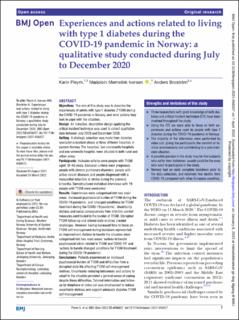| dc.contributor.author | Pleym, Karin | |
| dc.contributor.author | Iversen, Marjolein M. | |
| dc.contributor.author | Broström, Anders | |
| dc.date.accessioned | 2023-03-14T13:12:26Z | |
| dc.date.available | 2023-03-14T13:12:26Z | |
| dc.date.created | 2022-04-24T14:17:16Z | |
| dc.date.issued | 2022 | |
| dc.identifier.citation | BMJ Open. 2022, 12 (4), e056027-?. | en_US |
| dc.identifier.issn | 2044-6055 | |
| dc.identifier.uri | https://hdl.handle.net/11250/3058187 | |
| dc.description.abstract | Objectives
The aim of this study was to describe the experiences of adults with type 1 diabetes (T1DM) during the COVID-19 pandemic in Norway, and what actions they took to cope with the situation.
Design
An inductive, descriptive design applying the critical incident technique was used to collect qualitative data between July 2020 and December 2020.
Setting
A strategic selection was made from diabetes specialist outpatient clinics at three different hospitals in eastern Norway. The hospitals, two community hospitals and one university hospital, were situated in both rural and urban areas.
Participants
Inclusion criteria were people with T1DM aged 18–65 years. Exclusion criteria were pregnancy, people with chronic pulmonary disorders, people with active cancer diseases and people diagnosed with a myocardial infarction or stroke during the previous 6 months. Semistructured individual interviews with 19 people with T1DM were conducted.
Results
Experiences were categorised into two main areas: ‘increased psychosocial burden of T1DM during the COVID-19 pandemic’ and ‘changed conditions for T1DM treatment during the COVID-19 pandemic’. Uncertainty distress and social consequences from infection control measures contributed to the burden of T1DM. Disrupted T1DM follow-up and altered daily routines created challenges. However, having increased time to focus on T1DM self-management during lockdown represented an improvement. Actions to handle the situation were categorised into two main areas: ‘actions to handle psychosocial strain related to T1DM and COVID-19’ and ‘actions to handle changed conditions for T1DM treatment during the COVID-19 pandemic’.
Conclusions
Patients experienced an increased psychosocial burden of T1DM and difficulties from a disrupted daily life affecting T1DM self-management routines. Uncertainty-reducing behaviours and actions to adapt to the situation provided a general sense of coping despite these difficulties. Tailored information and follow-up by telephone or video call was emphasised to reduce uncertainly distress and support adequate diabetes T1DM self-management. | en_US |
| dc.language.iso | eng | en_US |
| dc.publisher | BMJ Publishing Group | en_US |
| dc.rights | Navngivelse 4.0 Internasjonal | * |
| dc.rights.uri | http://creativecommons.org/licenses/by/4.0/deed.no | * |
| dc.title | Experiences and actions related to living with type 1 diabetes during the COVID-19 pandemic in Norway: a qualitative study conducted during July to December 2020 | en_US |
| dc.type | Peer reviewed | en_US |
| dc.type | Journal article | en_US |
| dc.description.version | publishedVersion | en_US |
| dc.rights.holder | © Author(s) (or their employer(s)) 2022 | en_US |
| dc.source.pagenumber | e056027 | en_US |
| dc.source.volume | 12 | en_US |
| dc.source.journal | BMJ Open | en_US |
| dc.source.issue | 4 | en_US |
| dc.identifier.doi | 10.1136/bmjopen-2021-056027 | |
| dc.identifier.cristin | 2018673 | |
| dc.source.articlenumber | e056027 | en_US |
| cristin.ispublished | true | |
| cristin.fulltext | original | |
| cristin.qualitycode | 1 | |

